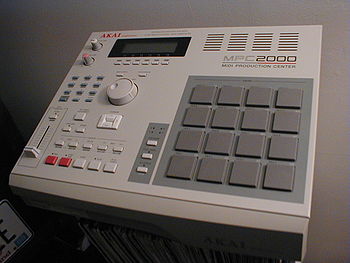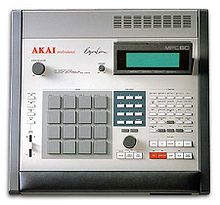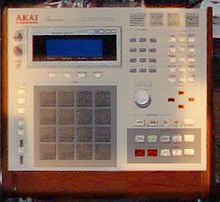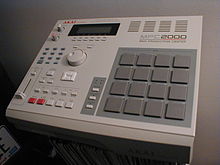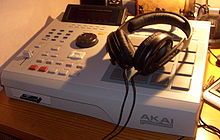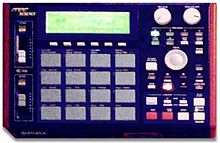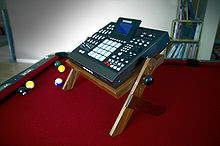- Music Production Center
-
Akai MPCs (originally MIDI Production Center, now Music Production Center) are a popular series of electronic musical instruments originally designed by Roger Linn and produced by the Japanese company Akai from 1988 onward. Intended to function as a powerful kind of drum machine, the MPCs drew on design ideas from machines such as the Sequential Circuits Inc. Studio 440 and the Linn's own Linn 9000, combining a powerful MIDI sequencer with the ability to sample one's own sounds. Later models feature increasingly powerful sampling, storage, interfacing and sound manipulation facilities, which broaden the use of instrument beyond just drum and rhythm tracks.
Contents
History
The original MPC60 was designed by Roger Linn, who was hired as a design consultant by Akai.[citation needed] He developed the functional design, including the panel layout and software/hardware specifications. He then created the software with a team of engineers. The hardware electronics were designed by English engineer David Cockerell and his team.[1] Cockerell was a founding member of the synthesizer firm EMS (co-creater of their famous VCS3 along with Peter Zinovieff,[2]), and then worked for effects manufacturers Electro-Harmonix.
Shortly after the MPC60's release, the MPC60-II was designed. Released in 1991, the MPC60-II offered most of the same features as the MPC60, with an added headphone output and a plastic housing replacing the original metal one.[3] In 1994, Akai released the MPC3000, which boasted 16-bit, 44 kHz sampling, 32-voice polyphony, and SCSI data transfer.[4] Akai developed and released the MPC2000 without Linn in 1997.[1] Akai tried to save money by dropping Roger Linn, the brainchild behind the MPC, to whom they would have to pay royalties on future models.[1] The MPC 2000 came with 2 MB of RAM, an optional effects board, and a 100,000 note 64-track sequencer.[5] The MPC2000 was replaced by the MPC2000XL in 2000. The MPC2000XL added an improved 300,000 note sequencer, a 64-track mixer and time-stretch and resample features. Four limited edition models of the MPC2000XL were released.[5]
In 2002 Akai unveiled the MPC4000, the most powerful MPC ever made (higher bitrate and resolution than the later 5000). The MPC4000 featured 8 assignable outputs, a hard drive and CD-ROM drive. The MPC4000's memory could be expanded to up to 512 MB of RAM, the largest amount on an MPC to date.[6] Only two years after the release of the MPC4000, Akai released the MPC1000, which was the smallest in the MPC product line at the time of its release. It was also the first MPC to utilize CompactFlash memory.[7] Both the MPC2500 and the MPC500 were added to the Akai MPC series in 2006. The MPC2500 is a mid-range MPC with 8 assignable outputs and CompactFlash storage.[8] Designed for portability, the MPC500 features 1 MIDI In/Out and CompactFlash storage, and can be powered by 6 AA batteries.[9]
MPC Models
The following MPC models are arranged in the order of their release date:
MPC60
The MPC60 is a 16 voice polyphonic 12-bit 40 kHz sampler / 99 track sequencer designed in large part by Roger Linn after Linn Electronics closed. It was similar to the Linn 9000. Akai released it in 1988. It had 750 kB memory standard, expandable to 1.5 MB. The sequencer is very flexible and powerful, famous both for its "swing" setting, and its easy to use step programming. It had 2 MIDI inputs / 4 MIDI outputs, allowing it to control up to 64 devices. The sequencer itself was offered as a separate product, known as the ASQ10, also released in 1988. The MPC60-II was nearly identical to the MPC60, but it featured a headphone output, and a plastic case, instead of the metal case of the original. It was released in 1991.
Features
- 16 velocity sensitive pads
- 2 pad banks (64 voices per program)
- sampling rate of 40 kHz (freq response 20 Hz - 18 kHz)
- 16-bit ADC and DAC, with data stored in special non-linear 12bit format (for lower noise)
- 750 kB sampling memory (13.1 seconds), upgradable to 1.5 MB (26.2 seconds) (expansion card: EXM003)
- 128 sounds in memory, 64 sounds per program, 16 voice polyphony.
- 2 MIDI inputs, 4 MIDI outputs
- 20 songs, 99 sequences, 99 tracks, 60,000 note capacity
- timing resolution of 96ppq (parts per quarter note)
- syncable via MIDI Time Code (MTC), MIDI Clock, FSK24, SMPTE, 1/4 note click.
- SMPTE supported frame rates: 24, 25, 29.97 drop, and 30.
- 8 assignable outputs + 1 stereo + 1 effects send/return
- Internal 3½" floppy drive (Double Density 720 kB)
- optional 3rd=party SCSI interface (by Marion Systems)[3]
MPC3000
The MPC3000 improved upon the MPC60 by adding 16-bit 44.1 kHz stereo sampling, increased memory, 32 voice polyphony, effects, filters, and SCSI. It was released by Akai in 1994. The MPC3000LE (Limited Edition) is identical to the MPC3000, except for its black custom design. It was released by Akai in 2000 and limited to 2000 units.[4]
Features
- 16 velocity sensitive pads
- 4 pad banks (64 voices per program)
- sampling rate of 16-bit 44.1 kHz stereo (freq response 20 Hz - 22.1 kHz)
- 2 MB sampling memory (22 seconds), upgradable to 32 MB (officially stated as 16 MB) (6 minutes)
- SPIDF stereo input
- 32 voice polyphony.
- 2 MIDI inputs, 4 MIDI outputs
- 20 songs, 99 sequences, 99 tracks, 75,000 note capacity
- timing resolution of 96ppq (pulses per quarter note)
- syncable via MIDI Time Code, MIDI Clock, FSK24, SMPTE, 1/4 note click.
- SMPTE supported frame rates: 24, 25, 29.97 drop, and 30.
- 8 assignable outputs + 1 stereo + 1 effects send/return
- Internal 3½" floppy drive
- SCSI[4]
MPC2000
The MPC2000 is a 64-track sampler/sequencer introduced in 1997 and discontinued in 2000. It comes with 2 MB sample memory as standard, and can be expanded to 32 MB. It supports a sampling rate of 44.1 kHz, in 16 bit stereo or mono.
Features
- 16 velocity sensitive pads
- Internal 3½" floppy drive
- 1 single button to access 4 pad banks
- 2 MIDI inputs, 2 MIDI outputs
- 100,000 note capacity 64-track sequencer
- 2 MB sampling memory (upgradable to 32 MB)
- Optional effects board (EB16)
- Optional 8 outputs and digital I/O board (IB-M208)
- SCSI interface[5]
MPC2000XL
The MPC2000XL is similar to the MPC2000 but with many newer features; including four independent pad-bank keys, number of samples stored doubled to 256 on the XL, altering sounds to a different bit depth or sampling rate could be accomplished by resampling, time stretch was added along with other features. In 2004 the 2000XL-MCD version was released, which features a CompactFlash card reader as standard in place of the floppy drive or Zip drives used in earlier models.[10] There were 4 limited edition 2000XL SE MPCs created between 2000 and 2003. There were two versions of the SE 1, one with an improved control surface, compatible with growing number of sound libraries and one with aesthetic changes. The Limited Edition SE 2 and SE 3 also had only aesthetic changes.[11] The 4 SE models can be seen here: http://www.loopers-delight.com/tools/akai/MPC2000/MPC2000.html.
Features- Multi-Voltage operation (100-240VAC, 50/60Hz, 13W (23W w/ options))
- Velocity sensitive pads with chromatic assignment for keygroups
- Internal 3½" floppy drive or 100MB Zip drive (upgradeable to a Zip 250MB) or MCD card reader with folder support for storage
- 4 independent Pad-Bank keys
- Adjustable angle screen
- Time stretch with 18 presets
- 2 MIDI inputs, 2 MIDI outputs
- Note-repeat key
- 300,000 note capacity 64-track sequencer
- 2 MB sampling memory (upgradable to 32 MB @ 3 min stereo/6 min mono)
- High Density 50 pin (HD50/HPDB50/SCSI 2) SCSI interface[5]
- AKAI MPC2000XL sample CD-ROM
- Optional effects board (#EB16)
- Optional 8 outputs and digital I/O board (#IB-M208)
MPC4000
 Akai MPC4000 with Zombie Nation
Akai MPC4000 with Zombie Nation
Released in 2002, the MPC4000 was intended by Akai as a "top-of-the-range" flagship product. Not only was it the most fully featured MPC product yet (building on the MPC60, 3000 and 2000XL), but it also incorporated the sampling engine from the latest model in Akai standalone sampler range, the Z8. The MPC 4000 was replaced by the MPC 5000 in spring 2008. The MPC4000 suffered from the poorest timing of all the MPC's though because it made use of a slow internal MIDI communication between the sequencer and the samplers voice engine. This was dropped in all future MPC models MPC1000, MPC500, MPC2500 & MPC5000.
Features- 16 velocity and pressure sensitive pads
- 2 MIDI inputs, 4 MIDI outputs
- 96 kHz 24bit sampling
- 16 MB sampling memory, upgradeable to 512 MB
- IDE bays for installation of internal hard disk drive and CD-ROM drive.
- Optional plug-in boards: Effects board, ADAT board, S/P-DIF & wordclock board, 8 analogue outputs board
- SCSI interface[6]
MPC2500
The MPC2500 is the mid-range of the Akai line of MPCs. It has a 100,000 note, 64 track mixer with 64 assignable MIDI channels. It has 16 MB of RAM standard and can be upgraded up to 128 MB of RAM with the AKAI EXM128 stick of RAM. It contains a USB port for computer connectivity. It contains a CompactFlash slot for storage of samples, and can be upgraded with a variety of hard drives. The MPC2500 contains 2 MIDI inputs and 4 MIDI outputs. The MP2500 also has the Chop Shop feature, which can chop a sample into as many as 64 pieces. A CD drive can be added for burning and reading capabilities. Also comes with a 128 mb compact flash card with sound kits. MPC2500 was discontinued in 2009.
Features
- USB port (Mass Storage Class)
- CompactFlash card reader
- 16 velocity sensitive pads
- 2 MIDI inputs, 4 MIDI outputs
- 100,000 note, 64-track, MIDI sequencer
- 16 MB sampling memory (upgradeable to 128 MB)
- Included standard effects include:Chorus, Flanger, Bit grunger, 4 band EQ, Compressor, Phase shifter, Tremolo, Flying Pan, Reverb, and Delay.
- It contains 8 assignable outputs and 1 stereo output.
- It has two assignable Q-link sliders and knobs.
- 240 x 64 hinged backlit LCD screen.
- The CD-M25 CD Drive can added.
- JJOS compatible[8]
MPC1000
The MPC1000 is a 64-track sampler/sequencer. It comes with 16 MB sample memory as standard, and can be expanded to 128 MB. It supports a sampling rate of 44.1 kHz, in stereo or mono. Its features include a USB port, an internal CompactFlash card reader, two MIDI inputs and outputs, and effects and multiple analog outputs as standard. Its sequencer's resolution is 96 ppq.
There have been many reported problems with the pad sensors in the 1000. In the original MPC1000 sensors, a thin square of carbon-impregnated rubber is glued at each corner above a copper coil. When a pad is depressed, this carbon-impregnated rubber is compressed against the copper coil, allowing current to pass through. This moving part can wear out, as the carbon-impregnated rubber sloughs away from the glue and eventually breaks loose.
In 2007, Akai offered a fix for this issue, retailing at 180 USD. The pad sensors design returned to the design of the pad sensors in previous models. This upgrade has been seen to be pre-installed on the MPC1000BK-N and some versions of the MPC1000BK, not the MPC1000 (blue outer casing). Before this change, a MPC 1000 user designed, built and sold kits of a pad fix under the name "Nym." Nym's kit is no longer available. By comparison, the more recent Akai pad fix uses better sensor technology (Sensitronic FSRs).[12]
Features
- USB port (Mass Storage Class)
- CompactFlash card reader
- 16 velocity sensitive pads
- 4 pad bank keys
- 2 MIDI inputs, 2 MIDI outputs
- 100,000 note capacity 64-track sequencer
- 16 MB sampling memory (upgradeable to 128 MB)
- Effects as standard
- Multiple analog outputs as standard
- Timestretch and pitch shift (added in OS 2.0)
- JJOS compatible[7]
MPC500
The MPC500 is the smallest MPC ever made and is the first truly portable MPC created. It can be run on 6 AA batteries but also can be run on a 12V DC plug. It combines a 48-track MIDI sequencer and a 32-voice stereo digital sampler. The MPC500 is the first MPC that only has 12 velocity sensitive rubber pads. It comes with 16 MB RAM but can be upgraded up to 128 MB of RAM. It has a CompactFlash slot for storage of samples. One major appeal of the MPC500 is the fact that you can take a project created on the MPC500 and transfer it to any current MPC with a CompactFlash reader. The MPC500 has a USB port for computer connectivity. It has one stereo output, making it the only MPC currently in production that does not have assignable outputs.
Features
- USB port (Mass Storage Class)
- CompactFlash card reader
- 12 velocity sensitive rubber pads
- Stereo L+R in & out
- 1 MIDI in and 1 MIDI out
- 4 pad banks
- 2 x 16 character LCD screen with back light
- Standard effects include:Chorus, Flanger, Bit grunger, 4 band EQ, Compressor, Phase shifter, Tremolo, Flying pan, Reverb, and Delay.
- Approximately 4.5 hours of continuous use with LCD backlight on.
- 465.5 sq CM footprint.[9]
MPC5000
With a listed MSRP of $3,500, the MPC5000 was launched at the 2008 winter NAMM trade show. Its main innovations were an 8-track streaming hard disk recorder, a 20-voice, 3-oscillator virtual analog synthesizer with arpeggiator, a new sequencing engine with 960 ppq resolution, pad and track muting and mixing, 64 continuous sample tracks. It also has a new FX engine with 4 FX buses and 2FX per bus, and is considered by Akai to be its flagship MPC.[13]
In addition, the MPC5000 features a 64-voice drum/phrase sampler with 64MB memory, expandable up to 192MB. The display is 240x128, twice the size of the MPC2500 and MPC1000. Integrated Chop Shop 2.0 now supports stereo chops and Patched Phrases. It is also the first MPC to include Random and Cycle sample playback in addition to velocity Zone Play. As on the MPC 4000, a turntable preamp is also included.
The MPC 5000 lacks some of the sample editing capabilities of the older MPC 4000, and also some of the hardware specs are lower than the MPC 4000 (max. 192 MB RAM vs. the 4000's 512 MB, and slightly smaller screen), but with an updated and more stable operating system.[14]
Comparison
The following table offers a side-by-side comparison of a variety of statistics across the MPC product-line. The specs for the MPC 1000 and 2500 refer to the original AKAI operating system, unless mentioned otherwise.
Model Release Date Price MIDI Inputs/Outputs Audio Outputs Sampling Rate Sampling Memory/Upgrade-able Sampling Time Storage Method Pad Banks Note Capacity Extra Features MPC60 1988 $5,000[15] 2 in, 4 out 8 + L/R 12-bit 40 kHz 750 kB / 1.5 MB (13.1 sec) / (26.2 sec) Internal 3½" floppy drive 4 60,000 MPC60 MK2 1991 $5,000[15] 2 in, 4 out 8 + L/R 12-bit 40 kHz 750 kB / 1.5 MB (13.1 sec) / (26.2 sec) Internal 3½" floppy drive 4 60,000 Headphone jack, Plastic case MPC3000 1993 $3,500[15] 2 in, 4 out 8 + L/R 16-bit 44.1 kHz 2 MB / 32 MB (22 sec) / (6 min) Internal 3½" floppy drive 4 75,000 -LE in 2000 with black case MPC2000 1997 $2,000[15] 2 in, 2 out Digital L/R + 8 (optional) 22 or 44.1 kHz 2 MB / 32 MB 6min mono/3min stereo Floppy/SCSI Interface 4 100,000 MPC2000XL 2000 $1,100[16] 2 in, 2 out Digital L/R + 8 (optional) 22 or 44.1 kHz 2 MB / 32 MB 6min mono/3min stereo Floppy/Zip Drive/CompactFlash/SCSI Interface 4 300,000 -Compact Flash drive, Internal SCSI connection, tilt screen MPC4000 2002 $3500[17] 2 in, 4 out L/R + 8 (optional) 96, 48 or 44.1 kHz, 16 or 24 bit 16 MB / 512 MB 96min / 64min (16/24 bit) Hard Drive/CD-ROM 6 300,000 IDE Bays MPC1000 2005 $1,000[18] 2 in, 2 out 4 + L/R 44.1 kHz 16 MB / 128 MB 136 sec / 24m28sec CompactFlash/Hard Drive 4 100,000 / 300,000 (With JJ OS Ver. 4.9 or OS2 Ver. 0.x,1.x) optional HDD MPC500 2006 $700[19] 1 in, 1 out L/R 44.1 kHz 16 MB / 128 MB 136 sec / 24m28sec CompactFlash 4 100,000 Smallest MPC Portable/Can run on 6 AA Batteries
MPC2500 2005 $1,700[20] 2 in, 4 out 8 + L/R 44.1 kHz 16 MB / 128 MB 136 sec / 24m28sec CompactFlash/CD-Rom/DVD-Rom/Hard Drive 4 100,000 built in 10 analog outs, optional CD drive, optional HDD MPC5000 2008 $3,500[21] 2 in, 4 out 8 + L/R 44.1 kHz 64 MB / 192 MB 12m48s/38m24s CompactFlash/CD-Rom/DVD-Rom/Hard Drive 4 100,000 VA Synth, 8 track direct-to-drive recording, 4 FX busses, Hard disk streaming of samples See also
External links
- AkaiPro.com
- Roger Linn Design New Version 3.10 software upgrade and Marion Systems SCSI hard disk interface kit for MPC60 I & II
- JJOS JJ OS for the MPC1000
- JJOS JJ OS for the MPC2500
- MPC-FORUM Discussion forum for MPCs
- Akai-Talk Discussion forum for MPCs and other Akai machines
Notes
- ^ a b c "Industry Interview -Roger Linn". 2007. http://www.sonicstate.com/articles/article.cfm?id=71&page=3. Retrieved 2007-07-04.
- ^ "The EMS History". 2007. http://www.ems-synthi.demon.co.uk/emsstory.html. Retrieved 2007-07-08.
- ^ a b "Akai MPC-60". 2007. http://www.vintagesynth.com/akai/mpc60.shtml. Retrieved 2007-07-03.
- ^ a b c "AKAI MPC-3000". 2007. http://www.vintagesynth.com/index2.html. Retrieved 2007-07-03.
- ^ a b c d "AKAI MPC-2000 / MPC-2000XL". 2007. http://www.vintagesynth.com/index2.html. Retrieved 2007-07-03.
- ^ a b "Akai MPC4000 Plus". 2007. http://akaipro.com/prodMPC4000.php. Retrieved 2007-07-03.
- ^ a b "MPC 1000: The Power of an MPC with the Portability of a Laptop". 2007. http://akaipro.com/prodMPC1000.php. Retrieved 2007-07-03.
- ^ a b "MPC 2500: Ultimate Production Power". 2007. http://akaipro.com/prodMPC2500.php. Retrieved 2007-07-03.
- ^ a b "MPC500 Production, Power and Next Level Portability". 2007. http://akaipro.com/prodMPC500.php. Retrieved 2007-07-03.
- ^ "MPC2000XL-MCD". 2007. http://akaipro.com/prodMPC2000XLMCD.php. Retrieved 2007-07-03.
- ^ "Akai MPC-2000 MIDI Production Center(XL, SE-1, SE-2, SE-3, XL with Zip)". 2007. http://www.loopers-delight.com/tools/akai/MPC2000/MPC2000.html. Retrieved 2007-07-03.
- ^ "The Pad Fix". 2007. http://nymantics.com/thepadfix/. Retrieved 2008-03-13.
- ^ Search
- ^ [1]
- ^ a b c d "Akai MPC 1000 REVIEW". 2007. http://www.onestopbeats.com/mpc1000review.html. Retrieved 2007-07-03.
- ^ "Akai MPC2000XL-MCD Production Station". 2007. http://www.musiciansfriend.com/product/Akai-MPC2000XLMCD-Production-Station?sku=705619. Retrieved 2007-07-03.
- ^ "Akai MPC4000 Plus Production Station with CDRW". 2007. http://www.musiciansfriend.com/product/Akai-MPC4000-Plus-Production-Station-with-CDRW?sku=705607. Retrieved 2007-07-03.
- ^ "Akai MPC1000 Music Production Center". 2007. http://www.musiciansfriend.com/product/Akai-MPC1000-Sequencer-Sampler?sku=705623. Retrieved 2007-07-03.
- ^ "Akai MPC500 Portable Music Production Center". 2007. http://www.musiciansfriend.com/product/Akai-Portable-Voice-Sampling-Sequencer-?sku=700344. Retrieved 2007-07-03.
- ^ "Akai MPC2500 Music Production Center". 2007. http://www.musiciansfriend.com/product/Akai-MPC2500-Music-Production-Center?sku=705621. Retrieved 2007-07-03.
- ^ "Akai MPC 5000 REVIEW". 2007. http://musicthing.blogspot.com/2008/01/akai-mpc5000-big-black-3500-groovebox.html.
Categories:- Akai synthesizers
- Samplers (musical instrument)
- Sequencers
- Sound modules
- Workstations
Wikimedia Foundation. 2010.

